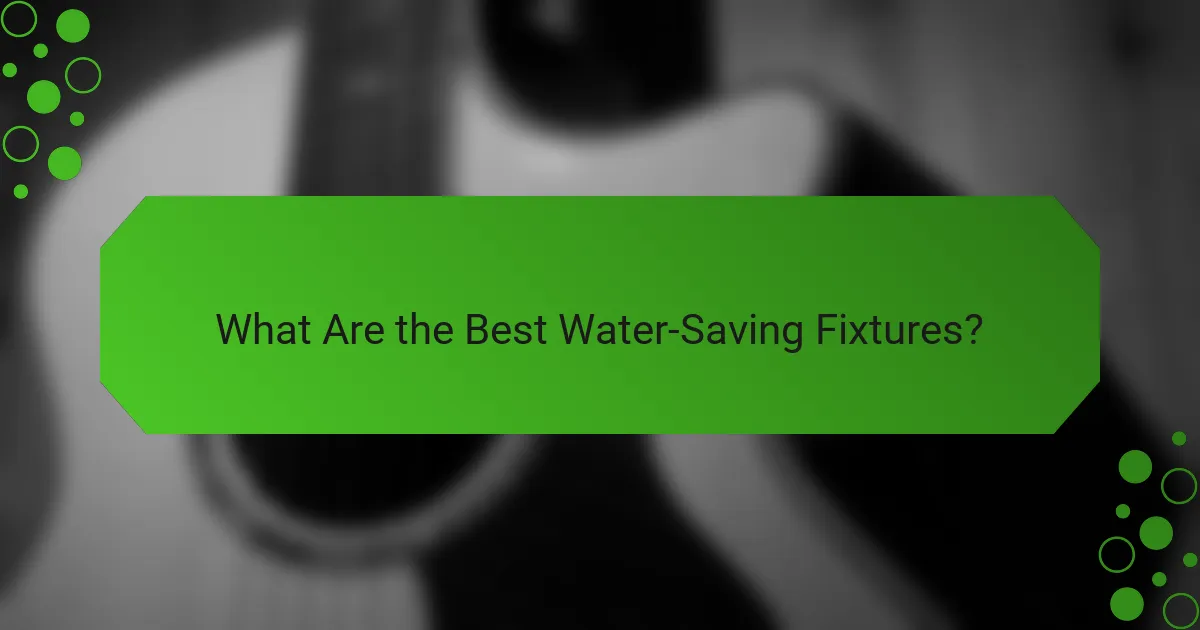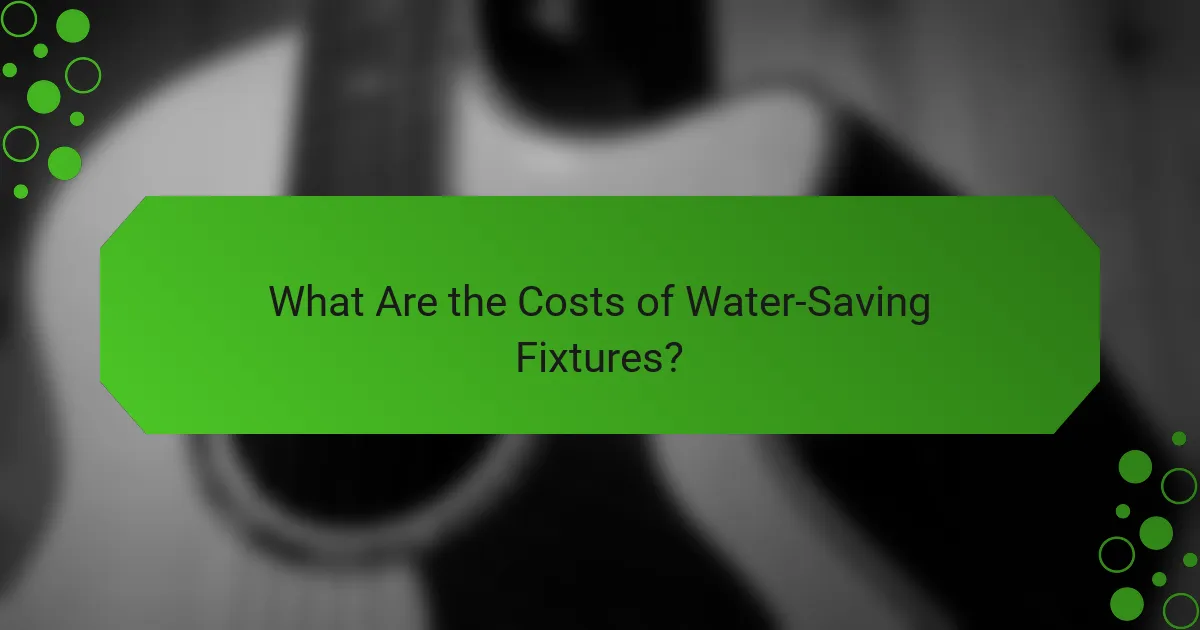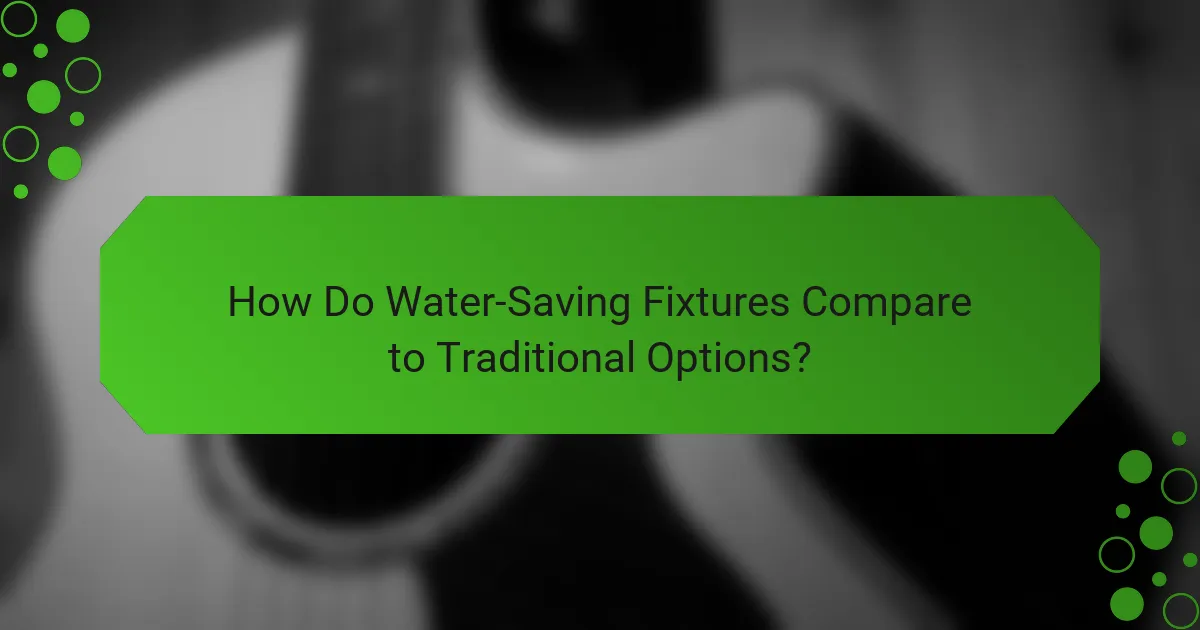Water-saving fixtures are essential devices that help minimize water usage without compromising functionality. By incorporating these fixtures into homes and businesses, users can enjoy lower utility bills and contribute to environmental conservation. The installation process is straightforward, typically involving the replacement of existing fixtures with more efficient models designed for optimal water conservation.

What Are the Best Water-Saving Fixtures?
The best water-saving fixtures include devices designed to minimize water usage while maintaining functionality. These fixtures can significantly reduce water consumption in homes and businesses, leading to lower utility bills and a positive environmental impact.
Low-Flow Showerheads
Low-flow showerheads are designed to use less water without sacrificing water pressure. They typically use 1.5 to 2.5 gallons per minute (GPM), compared to standard models that can use over 2.5 GPM. Installing a low-flow showerhead can save a household hundreds of gallons of water each year.
When selecting a low-flow showerhead, look for models that are WaterSense certified, as these meet strict efficiency criteria. Consider adjustable settings for versatility and comfort.
Dual-Flush Toilets
Dual-flush toilets offer two flushing options: a low-volume flush for liquid waste and a higher-volume flush for solid waste. This design can reduce water usage by 20-60% compared to traditional toilets, which use about 1.6 gallons per flush.
When choosing a dual-flush toilet, check for the EPA’s WaterSense label to ensure it meets efficiency standards. Proper installation is crucial for optimal performance, so consider hiring a professional if you’re unfamiliar with plumbing.
Water-Saving Faucets
Water-saving faucets are engineered to reduce flow rates while maintaining adequate pressure, typically using 1.5 GPM or less. These fixtures can help save significant amounts of water, especially in kitchens and bathrooms where faucets are frequently used.
Look for faucets with aerators, which mix air with water to create a steady stream while using less water. Installing faucet aerators is a simple DIY project that can enhance efficiency without requiring a full faucet replacement.
Smart Irrigation Systems
Smart irrigation systems optimize water use for landscaping by adjusting watering schedules based on weather conditions and soil moisture levels. These systems can reduce water waste by up to 50% compared to traditional irrigation methods.
When implementing a smart irrigation system, consider models that integrate with weather data and allow for remote control via smartphone apps. Regular maintenance and calibration are essential to ensure the system operates efficiently.
Rainwater Harvesting Systems
Rainwater harvesting systems collect and store rainwater for non-potable uses such as irrigation and toilet flushing. These systems can significantly reduce reliance on municipal water supplies and lower water bills.
To set up a rainwater harvesting system, install gutters and downspouts that direct water into storage tanks. Ensure compliance with local regulations regarding rainwater collection, and consider filtration systems if you plan to use the water for irrigation or other applications.

What Are the Benefits of Water-Saving Fixtures?
Water-saving fixtures provide significant advantages, including lower water bills, reduced environmental impact, and increased property value. These fixtures are designed to use less water without sacrificing performance, making them an efficient choice for homeowners and businesses alike.
Reduced Water Bills
Installing water-saving fixtures can lead to noticeable reductions in monthly water bills. For example, low-flow showerheads and faucets can reduce water usage by 20-30%, translating to savings of several dollars each month.
To maximize savings, consider replacing older fixtures that may use more water than necessary. Look for products that meet WaterSense standards, which can help ensure efficiency and performance.
Environmental Impact
Water-saving fixtures contribute positively to the environment by conserving water resources. By using less water, these fixtures help reduce the strain on local water supplies and decrease energy consumption associated with water heating and distribution.
In regions facing water scarcity, such as parts of the southwestern United States, adopting water-efficient fixtures can play a crucial role in sustainable living. This not only benefits the environment but also promotes responsible water use within communities.
Increased Property Value
Homes equipped with water-saving fixtures often see an increase in property value. Potential buyers are increasingly looking for energy-efficient and water-efficient features, making these upgrades attractive during the selling process.
When considering upgrades, focus on high-impact areas such as bathrooms and kitchens. Fixtures like dual-flush toilets and aerated faucets can enhance both functionality and appeal, making your property stand out in the market.

How to Install Water-Saving Fixtures?
Installing water-saving fixtures can significantly reduce water usage and lower utility bills. The process generally involves replacing existing fixtures with more efficient models designed to conserve water while maintaining performance.
Installation of Low-Flow Showerheads
To install a low-flow showerhead, first, remove the existing showerhead by turning it counterclockwise. Clean the threads of the shower arm, then apply plumber’s tape to ensure a watertight seal. Finally, screw the new low-flow showerhead onto the arm by turning it clockwise.
Low-flow showerheads typically use 1.5 to 2.0 gallons per minute (GPM), compared to standard models that may use over 2.5 GPM. This change can lead to significant water savings without sacrificing water pressure.
Installing Dual-Flush Toilets
Installing a dual-flush toilet involves removing the old toilet and replacing it with a new model that features two flush options: one for liquid waste and another for solid waste. Begin by turning off the water supply, draining the tank, and disconnecting the old toilet.
Once the old toilet is removed, position the new dual-flush toilet over the flange, secure it with bolts, and connect the water supply. Dual-flush toilets can save around 30% more water compared to traditional toilets, making them an excellent choice for conservation.
Faucet Replacement Steps
To replace a faucet, start by shutting off the water supply and draining the existing faucet. Use a basin wrench to loosen the nuts securing the faucet to the sink, then remove the old faucet. Clean the area before installing the new faucet, ensuring all gaskets are in place.
New water-saving faucets often use 1.5 GPM or less, compared to older models that may use 2.2 GPM or more. This upgrade can lead to noticeable reductions in water usage, especially in households with multiple faucets.

What Are the Costs of Water-Saving Fixtures?
The costs of water-saving fixtures vary widely based on type, brand, and features. Generally, investing in these fixtures can lead to significant savings on water bills over time, making them a cost-effective choice for many households.
Average Prices for Showerheads
Water-saving showerheads typically range from around $20 to $100. Basic models may offer a flow rate of 1.5 to 2.0 gallons per minute (GPM), while more advanced options can include features like adjustable spray patterns and temperature control.
When selecting a showerhead, consider the balance between price and performance. Higher-priced models often provide better durability and efficiency, which can enhance your overall shower experience.
Cost of Dual-Flush Toilets
Dual-flush toilets generally cost between $200 and $600, depending on the design and brand. These toilets allow users to choose between a full flush for solid waste and a reduced flush for liquid waste, significantly reducing water usage.
While the initial investment may be higher than traditional toilets, dual-flush models can save a household thousands of gallons of water annually, leading to lower water bills and a quicker return on investment.
Faucet Price Range
Water-saving faucets usually range from $30 to $150. Many models feature aerators that reduce flow rates to 1.5 GPM or less without sacrificing water pressure. This can lead to noticeable savings on water consumption.
When purchasing a faucet, look for certifications like WaterSense, which indicates that the product meets efficiency standards set by the Environmental Protection Agency. This can help ensure you’re making a smart investment in water conservation.

How Do Water-Saving Fixtures Compare to Traditional Options?
Water-saving fixtures are designed to use significantly less water than traditional plumbing options while maintaining performance. They achieve this through advanced technology and design, making them an eco-friendly choice that can also reduce utility bills.
Efficiency Comparison
Water-saving fixtures, such as low-flow faucets and showerheads, typically use 20-60% less water than standard models. For example, a traditional showerhead may use 2.5 gallons per minute (GPM), while a water-saving model often uses 1.5 GPM or less. This efficiency not only conserves water but also reduces energy consumption associated with heating water.
When selecting fixtures, look for those that meet EPA WaterSense standards, which ensure they provide adequate performance while using less water. This certification can help guide your choices and ensure you are investing in efficient products.
Long-Term Savings
Investing in water-saving fixtures can lead to substantial long-term savings on water bills. Households can save tens to hundreds of dollars annually, depending on usage and local water rates. For instance, replacing a standard showerhead with a low-flow model can save approximately 1,000 gallons of water per year.
In addition to water savings, reduced energy costs for heating water can further enhance overall savings. Over time, these fixtures can pay for themselves through lower utility bills, making them a financially smart choice.
Performance Differences
While some consumers worry that water-saving fixtures may compromise performance, many modern designs effectively balance water conservation with functionality. Low-flow showerheads and faucets are engineered to maintain pressure and flow rate, ensuring a satisfying user experience.
It’s essential to choose high-quality fixtures from reputable brands to avoid performance issues. Look for reviews and ratings to find products that deliver both water savings and reliable performance, ensuring you don’t sacrifice comfort for conservation.
